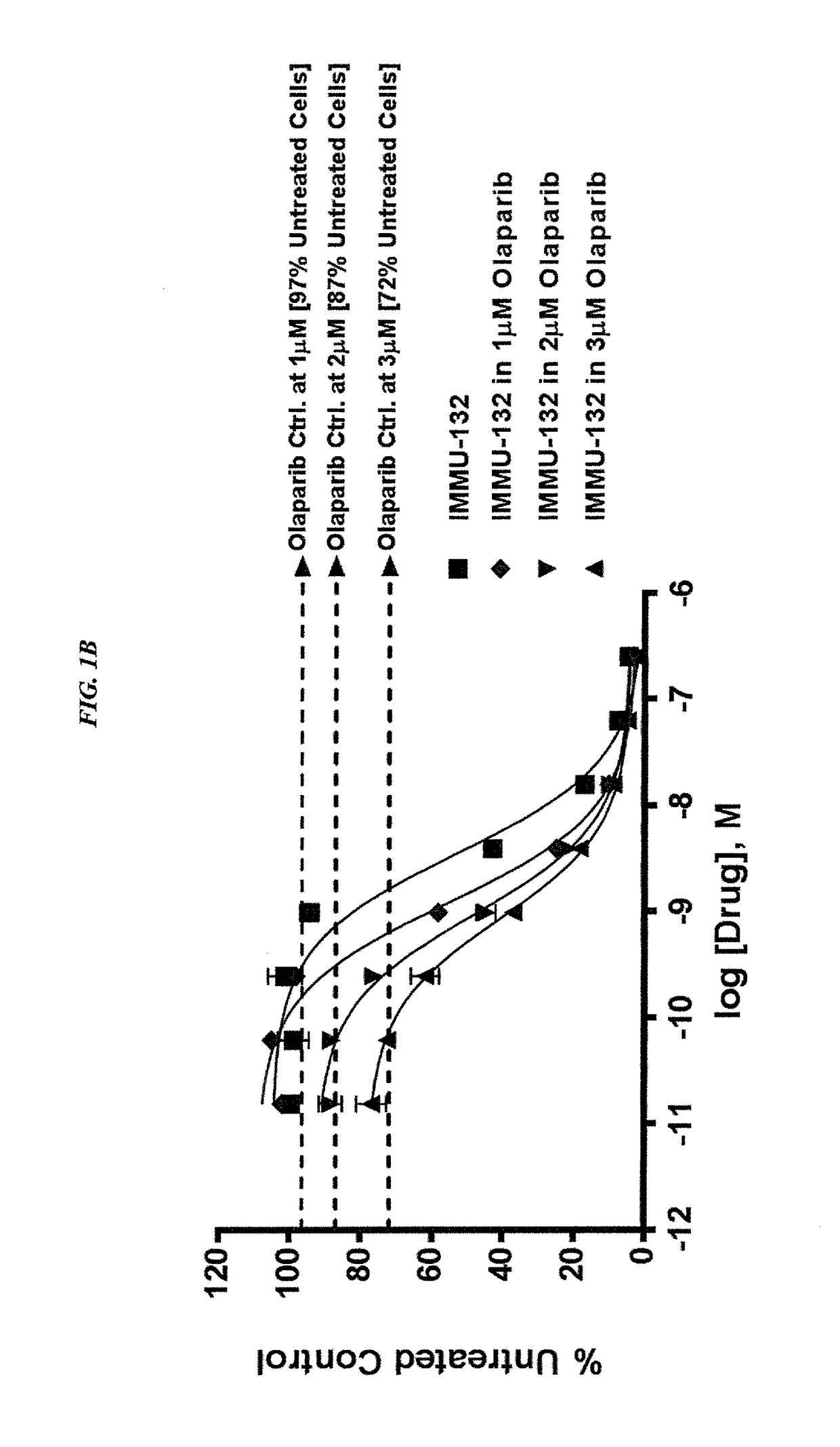Combining anti-HLA-DR or anti-Trop-2 antibodies with microtubule inhibitors, PARP inhibitors, bruton kinase inhibitors or phosphoinositide 3-kinase inhibitors significantly improves therapeutic outcome in cancer
a technology of anti-trop-2 and anti-hla-dr, which is applied in the field of therapeutic use of antitaa antibodies or immunoconjugates, can solve the problems of mixed success in the treatment of human cancer, virtually no application in other diseases, and insolubility of most cpt derivatives in aqueous buffers
- Summary
- Abstract
- Description
- Claims
- Application Information
AI Technical Summary
Benefits of technology
Problems solved by technology
Method used
Image
Examples
example 1
on Therapy with ADC IMMU-132 and Microtubule Inhibitors or PARP Inhibitors
[0242]In current clinical trials (ClinicalTrials.gov, NCT01631552), triple-negative breast cancer (TNBC) patients treated with IMMU-132, which is composed of the active metabolite of irinotecan, SN-38, conjugated to an anti-Trop-2 antibody, shows manageable toxicity and very encouraging responses in relapsed / refractory cases.
[0243]Synthetic lethality is a concept in which a cell harboring one out of two possible gene or protein defects is viable, while a cell containing both defects is nonviable. BRCA1 / 2 mutations are linked to deficiencies in DNA repair and are associated with TNBC. Other repair mechanisms involve poly(adenosine diphosphoribose) polymerase (PARP), which can be used by cancer cells to overcome loss of BRACA1 / 2. Treatment of TNBC cells with either IMMU-132 or paclitaxel results in cleavage and deactivation of PARP, whereas the small molecule olaparib directly inhibits PARP. Therefore, the ratio...
example 2
on Therapy with IMMU-114 (Anti-HLA-DR) Plus Bruton Kinase Inhibitor in Chronic Lymphocytic Leukemia (CLL)
[0275]Experimental Design.
[0276]Human chronic B cell leukemia cells (JVM-3) were plated in a 96-well plate. Cells were then incubated with various doses of the Bruton kinase inhibitor ibrutinib (1×10−5 to 3.9×10−9M) plus a constant amount of IMMU-114 (0.25, 0.5, 0.75, or 1 nM) for 96 h. Cell viability was assessed by MTS assay and dose / response curves were generated based on percent growth inhibition relative to untreated control cells. IC50-values were determined using Prism Graph-Pad. Data were normalized and isobolograms generated to demonstrate the effect of IMMU-114 on ibrutinib in JVM-3 cells.
[0277]Results
[0278]An example of how IMMU-114 shifted the IC50 of ibrutinib is shown in FIG. 5A. Cells incubated with ibrutinib alone resulted in an IC50 of 2.2×10−6M. However, when 0.5 nM of IMMU-114 is combined with ibrutinib, the IC50-value drops 2-fold to 1.08×10−6M. It should be n...
example 3
on Therapy with IMMU-114 (Anti-HLA-DR) Plus Phosphatidylinositide 3-Kinase (PI3K) Inhibitor in Chronic Lymphocytic Leukemia (CLL)
[0280]Experimental Design.
[0281]Human chronic leukemia B cells (JVM-3) were plated in a 96-well plate. Cells were then incubated with various doses of a PI3K inhibitor idelalisib (1×10−5 to 3.9×10−9M) plus a constant amount of IMMU-114 (0.25, 0.5, 0.75, or 1 nM) for 96 h. Cell viability was assessed by MTS assay and dose / response curves were generated based on percent growth inhibition relative to untreated control cells. IC50-values were determined using Prism Graph-Pad. Data were normalized and isobolograms generated to demonstrate the effect of IMMU-114 on ibrutinib in JVM-3 cells.
[0282]Results
[0283]As with ibrutinib, IMMU-114 shifted the IC50 of idelalisib in JVM-3 cells (FIG. 5B). Cells incubated with idelalisib alone resulted in an IC50 of 1.51×10−6M. However, when 0.5 nM of IMMU-114 is combined with idelalisib, the IC50-value drops 2-fold to 0.77×10...
PUM
| Property | Measurement | Unit |
|---|---|---|
| size | aaaaa | aaaaa |
| refractory | aaaaa | aaaaa |
Abstract
Description
Claims
Application Information
 Login to View More
Login to View More - R&D
- Intellectual Property
- Life Sciences
- Materials
- Tech Scout
- Unparalleled Data Quality
- Higher Quality Content
- 60% Fewer Hallucinations
Browse by: Latest US Patents, China's latest patents, Technical Efficacy Thesaurus, Application Domain, Technology Topic, Popular Technical Reports.
© 2025 PatSnap. All rights reserved.Legal|Privacy policy|Modern Slavery Act Transparency Statement|Sitemap|About US| Contact US: help@patsnap.com



